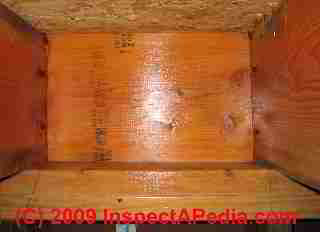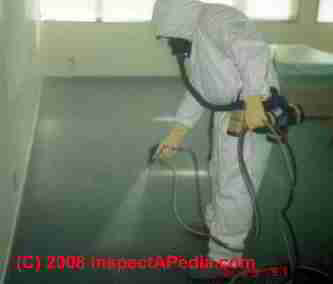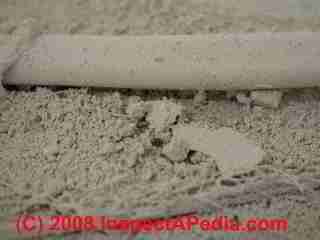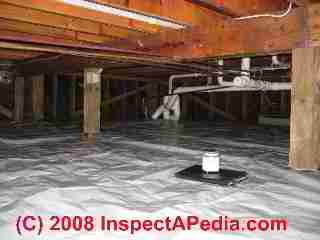 Guide to Using Crawl Space Sealants & Sanitizers
Guide to Using Crawl Space Sealants & Sanitizers
- POST a QUESTION or COMMENT about how to sanitize & seal a crawl space
How to sanitize & seal a crawl space after a crawl space water or mold or sewage backup cleanup job.
Advice for using spray sanitizers, sealants, disinfectants in crawl spaces following crawl space cleanup or mold removal.
Using a sealant can reduce future mold growth and help keep a crawl space dry - steps that in turn may also improve building indoor air quality - but don't rely on sprays alone to "cure" a wet, damp, moldy, or contaminated crawl area.
InspectAPedia tolerates no conflicts of interest. We have no relationship with advertisers, products, or services discussed at this website.
- Daniel Friedman, Publisher/Editor/Author - See WHO ARE WE?
How to Sanitize and/or Seal Crawl Space Surfaces including the floor: is it needed?
 When Is it Good Practice to Use Biocides, Sanitizers, or Fungal sprays in a Crawl Space or in Other Building Areas?
When Is it Good Practice to Use Biocides, Sanitizers, or Fungal sprays in a Crawl Space or in Other Building Areas?
[Click to enlarge any image]
- First it is important to physically remove contaminated or moldy materials
and debris or materials and debris that have been contaminated with sewage or flood water sludge and mud. - Second it is important to physically clean the contaminated surfaces
in a crawl space such as moldy joists or subflooring. - Third, use of a biocide, disinfectant, or surface encapsulating spray as a final step
makes people feel more confident about the mold or sewage cleanup, but although this is a widespread practice, the use of biocides is questioned by experts.
One could certainly question the usefulness, effectiveness, and wisdom of spraying carpeting such as shown in our photo. If the carpeting is so infected as to "need" spraying with a disinfectant, it should be removed and the surfaces cleaned instead.
Anabec NG2000™ and Bioshield BST Protectant RTU75™ are products used in mold remediation projects. These companies produce fungicides and fungicidal sealants as well as related items.
CalBrite™ (Caltex International) was sold to one of our clients as a biocidal spray but the client's product's package indicated that it was a deck cleaner. And while online access to product literature described the product as a deck cleaner, that document was later removed from public view. We were left confused. The company makes a variety of products used in or on buildings.
Links to find these products are atReferences or Citations .
In general, deck spray cleaning products are intended for outdoor use to clean wood-framed decks and deck surfaces. A representative of the company stated that information here is incorrect, but was unwilling to provide specifics. In a singularly ugly response to our telephone request for clarifying information, the Caltex™ president declined to provide any information whatsoever, though a later letter from the company's lawyers explained that the company describes its product as a "sanitizer" not a biocide.
At MOLD SANITIZER, SPRAY, BIOCIDE USE GUIDE we sort through these terms and help clear up consumer confusion among these terms including biocide, disinfect, sanitize, and sterilizer and we include recommendations from an expert on the use or non-use of chemicals to try to kill mold.
Microban Nuocide™ ( Microban antimicrobial products) (produced by a company whose contact was more pleasant) is an example of a broad spectrum biocidal spray that is in wide popular use by mold and flood damage remediation contractors.
Also see Protex™ 63, a sealant and coating formulated for exterior use.
When is it Good Practice to use Fungicidal Sealants and Encapsulant Sprays in a Crawl Space or in Other Building Areas?
For full details of this topic, please see MOLD SANITIZER, SPRAY, BIOCIDE USE GUIDE. The basics are just below.
 ...
... 
Clean the crawl space, don't just spray it: Do not, however, permit the use of biocides, disinfectants, sprays, or encapsulants as a substitute for the physical cleaning that must come first.
Otherwise there is risk that you will leave harmful contaminants and particles in the building, and it is likely that cleanup will be inadequate. Look at the thick debris sprayed-over in this building. Simply stirring the debris shows that this approach was ineffective.
Fiberlok IAQ 6000 HD™ (above, left, misapplied right over a high volume of loose debris), Anabec X70™ waterborne sealant, and Fosters 4051™ (clear coating shown at above right) produce sealants frequently used by mold and flood damage remediation companies.
Links to find all of these products are atReferences or Citations
Should You Ventilate the Crawl Space?
Usually not. See CRAWL SPACE VENTILATION CODES
Keep the Crawl Space Dry
Once the crawl area has been cleaned of debris and moldy materials, and crawl space water has removed, and after we've eliminated the sources of crawl space water entry, we are ready to take the next steps to keep the crawl area clean and dry.
See CRAWL SPACE WATER ENTRY STOP
Details about use of fungicidal sealants and sprays are
at MOLD SANITIZER, SPRAY, BIOCIDE USE GUIDE.
This article series describes the steps needed to get into, inspect, clean, and then dry out a building crawl space.
We give a step by step crawl space entry, inspection, cleanout, dryout and keep dry guide explains how to get into or inspect a crawl space even if there is no ready access, how to assess crawl space conditions, how to stop water that is entering the crawl area, how to dry out the space, how to clean up and if necessary disinfect or sanitize the crawl space, and how to keep out crawl space water and moisture in the future.
...
Reader Comments, Questions & Answers About The Article Above
Below you will find questions and answers previously posted on this page at its page bottom reader comment box.
Reader Q&A - also see RECOMMENDED ARTICLES & FAQs
On 2014-06-02 - by (mod) -
this article on checking for trapped mold between flooring layers may help you
https://inspectapedia.com/mold/Mold_Traps.htm
Normally my opinion is we want to remove all of the problem mold reservoir. This does not mean a "mold free building" which would be nonsense, it means removing problem mold contaminations - moldy material, or cleaning harder surfaces.
If you eliminate moisture and prevent its recurrence, the mold will remain but should not continue to propagate. The risk is that by having a big inoculation of mold, when conditions change re-growth could be more rapid than otherwise.
Fogging may render some but not all spores non-viable - that is inhibit future growth. And sealants that reduce moisture up-take also help reduce future mold growth. But the chief mold prevention steps are removing the problem mold and fixing the reason it grew in the building. If you don't do the second step, no amount of cleaning is enough.
Clean, seal exposed wood surfaces when they're dry, and fix the moisture sources.
On 2014-06-02 by Mold trapped in between floor under tub.
I also will be replacing the insulation with foam board instead as you suggest. I am also considering venting with a fan that is controlled by a de-humidistat and thermostat.
I would appreciate any other solutions that would save me from removing my tub and flooring. Thanks, Virginia
On 2014-06-02 by Mold Odor returns in summer after cleanup--mold trapped in between floor?
I had a pin hole leak in a faucet in the master bedroom which is on a crawl. Have no clue how long it was saturating the floor (hardwood with subfloor).
During a terribly hot summer a horrible odor began to permeate my basement through the opening to the crawl. I never had a problem with mold or odor in 16 years because for the most part the air in the crawl was conditioned because it was receiving the heat and air conditioning through the opening.
After discovering the odor was due to flooring and insulation that got wet from the leak, we tore out only the wet insulation with mold growth) but not all because its a large space. we cleaned the floor joists that were exposed with bleach water and removed roofing paper the previous owner had spread on the dirt.The floor under my tub was black with mold so I scrubbed as far as I could reach and sprayed bleach where I couldn't.
Everything smelled great until the following summer. I sleep above the crawl and sneeze 20 times each morning. I am considering using Concrobium that is used with a fogger to eliminate existing mold and prevent mold regrowth , sealing with a product called Aftershock ( EPA Registered Fungicidal Coating).
After reading your info have decided on putting plastic on the dirt & gravel floor (which is dry-no water issue).I am concerned now that I have read your information regarding trapped mold in flooring.
I believe I should perform the test of drilling the subfloor from below because the odor may be coming from trapped mold under the the tub. What do you think?
Question: using a sealer and vapor barrier in a crawl space
I live in the Wyoming mountains (9000 Ft) in a very dry climate, 15" of rain a year which includes average 3-4 feet of snow in the winter. The house is 45 years old. There were only two small vents in the crawl space. When an addition was built on the south end of the house 6 years ago,one vent was blocked by the addition which had a separate crawl space and vapor barrier installed. Last year we had record snowfall & high ground water, within 6" of outside grade.
I had a floor joists sagging in a bedroom and then I found white furry mold on a baseboard on the north end of the house. I pulled up the carpet and pad and on then inspected the crawl space below the two bedrooms found mold on the joists and subfloor with three joists rotting out under one bedroom and much less mold under the other bedroom which is on the other side of the main support beam..and a very wet space.
The vertical two by fours in the walls and blow-in insulation inspected so far are dry and show no mold.
I had a contractor look at it and have decided to seal off the two bed rooms and remove the floors and joists completely in both rooms, remove a couple inches of dirt, dry out the crawl space, clean all the other visible mold by the methods you describe throughout the entire space, and rebuild the joists with pressure treated wood and new sub floors. And install more piers for support of the floor.
I thought about spraying a sealer or oil based Kilz after the cleaning? I am also planning to put a vapor barrier in.
Due to the dry climate (typically not over 30% RH unless it is snowing or raining and usually less than 20%), put in several vents as well rather then heat it due to the future possibility of high groundwater due to high snow level. I am also considering a fan to continuously move air, but the wind here blows almost every day due to the altitude in the mountains.
Do you have any comments or other suggestions? - J.R. Jay
Reply:
JR even in a dry climate that has just periodic rainfall, leaks and water entry are asking for a mold or rot or insect problem. Your cleanup sounds thorough but I didn't see much about tracking down exactly where the water is leaking in. It's better to keep water out than to let it in and then get rid of it or to try to waterproof the interior against it.
Reader Followup:
I have now found that the water was migrating up from snowmelt to the sill plate on the top of the foundation. The contractor that did some repair of dry rot rim joist on the north end of the house before it was resided with stucco.
The contractor put Ice and Water Shield on the foundation down about 10 inches into the soil, and then had the Stucco contractor extend the 1/2" styrofoam board 12 inches into the soil as well thinking that all this would seal and insulate the foundation. When I pulled off the ice and water shield and the blue styrofoam the foundation was soaking wet underneath.
I have now removed all that mess and the foundation is drying out. With the amount of snowmelt that we have in the spring I think that is the main source of problem coupled with the reduced ventilation of only one small vent to the crawl space.
Question: how to dry out a crawl space after a toilet flood of more than 100,000 gallons into the crawl space
Our home flooded due to toilet break. 3 weeks water ran totaling 130,500 gallons of water. A company mediated our home, neglecting the crawl. I went under and dug down 6" the dirt was damp. How do we dry this out? - Ronald 7/22/12
Reply:
Ronald I'd suggest starting crawl space dryout with a review of the suggestions in the article above - that's my best shot. When you've got the in crawl surfaces dry you'll want to take a look at the additional topics (see crawl space links near the top left of this page) such as how to put down a plastic moisture barrier to stop soil pumping moisture into the building.
Question: gutted house being renovated, mold like stuff on floor joists
I just bought a house that was mostly gutted when I got it. Neighbors tell of roof leaks and mold, though what was left on interior walls had no evidence of mold. Still, I finished the demo, removing everything down to stud walls and floor joists.
Much of the subfloor (old chipboard and thin OSB - house was built in 1980) was rotted, to varying degrees. There was much mold-like substance on the floor joists - (I've been all over your website trying to determine the type) but they include the black cosmetic mold, brown fuzzy mold (not the hair-looking stuff, but sort of looked like spun cotton candy), white stuff, a little bit of yellow stuff. I'm using the folded rag method to clean with water and anti-bacterial soap, with a little bit of bleach for good measure. It seems to be working well.
My builder is now putting down new Advantek subfloor, as I'm finishing the cleaning. I'm also cleaning out the crawlspace as recommended, removing all the debris, the old poly, all insulation, etc. There is water encroachment during rains from one corner of the house where the gutters aren't working and the ground slopes towards the house.
Obviously, those last two things must be corrected immediately. The crawlspace had a few areas of standing water after the last significant rain. It had dissipated by the time I started the cleanup down there. However, under the plastic, some of the ground (red clay, here in NC) is pretty wet. Where I had removed the plastic, it has started to dry out pretty quickly. (three days?)
So, is it okay to let my builder complete the subfloor installation while I continue to clean the crawlspace, or would I be better served to have him wait to complete until I'm done? Should I leave the plastic off for a period of time to let the ground dry out before replacing it?
Also, there are a few small visible roots under there that themselves look moldy - black and spidery. What of that? The ground is uneven and I'll smooth it out to eliminate the low spots, but I'm uncertain as to what is the best next step. - Charlene Blevins 10/21/2012
Reply:
Charlene Blevins
It sounds as if your approach is reasonable, especially with the attention to outside sources of water entry;
If you address the sources of water entry, clean and dry the crawl area, and put down gravel and poly those are good steps; but if the area is going to be chronically wet I still expect trouble; I'd be adding an interior drain similar to what Walden is considering, along with perhaps dehumidification.
I'm not too concerned about soil roots & stuff that will be dried and covered by gravel and poly.
Question: Hurricane Sandy flooded our Ocean City NY House - what do I do in the crawl space?
Hurricane Sandy hit my old Sears House (1930's)in Ocean City, NJ so the water was 1 foot deep on the first floor (the floor being 3 feet off the ground!) Sometime within the last 25 years the water was deep enough to get the insulation wet and it was removed at that time and not replaced (The house is not heated in the winter).
What should I do in the crawl space area? If I would encapsulate the crawl space, it would be like a swimming pool next time it floods. Ideas on a good solution? Is a spray insulating foam worthwhile for protecting flooring from underneath? Thanks!
Rick - 11/12/2012
I have also a home in Ocean City, NJ that got hit with Sandy. I have just pulled out the mostly wet insulation. I got water damaged in my first floor from the water seeping up from the craw space. Electric wires are down now and I am worried about structural damage.
Can anyone recommend someone in South Jersey who could do work of reinforcing existing floor supports?
These past week I am worried that those who are hired to do work are being extremely careless and doing other damage. THanks - Roberta 11/13/2012
Reply: tips for improving the resistance of crawl spaces to flood damage
Closed-cell foam products are somewhat resistant to wetting from flooding or other water intrusion in a building crawl space or anywhere else, but if a building area is actually inundated with floodwaters again after such an installation, I'd be concerned about the difficulty and cost of disinfecting or addressing the risks of sewage-contaminated floodwaters.
For this reason, just taking up some closed cell foam board can be problematic - how will you clean the space that was soaked with sewage waters between the foam boards and framing or subfloor above?
Talk with spray foam insulation contractors in your area about the water resistance of sprayed-in-place closed cell foam insulation. That product actually adheres to wood surfaces, a step that may resist sewage-contaminated water from entering the space between the insulation itself and wood surfaces that otherwise would need cleaning.
See
- CRAWL SPACE INSULATION RETROFIT
- Open-celled vs. Closed-cell Foam Insulation and take a look at and compare
- Foam Insulation Types - Visual Id of different types of foam insulation products
In addition, sealing the exposed wood and interior foundation surfaces with a sanitizing or fungicidal sealant (after they are thoroughly dry) will also reduce the moisture uptake (and sewage-contaminated water uptake) of those surfaces in future flooding, making surface cleaning and area dryout a bit faster after the next flood.
- See MOLD SANITIZER, SPRAY, BIOCIDE USE GUIDE for details. Our photo above shows a crawl space after an extensive cleanup; the remediator installed 6 mil or heavier plastic on the crawl space floor, and all surfaces were coated with a sealant.
- Also take a look at FLOOD VENTS & FLOOD PORTS - a product installed to deliberately allow floodwaters into a basement or crawl space to reduce the risk of foundation collapse due to outside floodwater pressures.
Frankly, if the home is likely to be flooded to a depth that submerges the first floor or higher, no crawl space encapsulation is going to completely protect the building; if you cannot afford to raise the building on a taller, flood-damage-resistant foundation or pier system, I'd be troubled about the prospect of recurrent, perhaps even increasingly frequent significant cleaning and repair costs from future area flooding.
...
Continue reading at CRAWL SPACE WATER ENTRY STOP or select a topic from the closely-related articles below, or see the complete ARTICLE INDEX.
Or see these
Recommended Articles
- CRAWL SPACE CLEAN UP
- CRAWL SPACE DEBRIS
- CRAWL SPACE DISINFECTANTS & SANITIZERS, SOURCES
- CRAWL SPACE DRYOUT - home
- CRAWL SPACE INSULATION RETROFIT
- CRAWLSPACE MOLD ADVICE
- CRAWL SPACE SAFETY ADVICE
- CRAWL SPACE SEWAGE CLEANUP
- CRAWL SPACE VAPOR BARRIER LOCATION
- CRAWL SPACE VENTILATION CODES
- CRAWLSPACE MOLD ADVICE
Suggested citation for this web page
CRAWL SPACE SEAL & SANITIZE at InspectApedia.com - online encyclopedia of building & environmental inspection, testing, diagnosis, repair, & problem prevention advice.
Or see this
INDEX to RELATED ARTICLES: ARTICLE INDEX to CRAWL SPACES
Or use the SEARCH BOX found below to Ask a Question or Search InspectApedia
Ask a Question or Search InspectApedia
Try the search box just below, or if you prefer, post a question or comment in the Comments box below and we will respond promptly.
Search the InspectApedia website
Note: appearance of your Comment below may be delayed: if your comment contains an image, photograph, web link, or text that looks to the software as if it might be a web link, your posting will appear after it has been approved by a moderator. Apologies for the delay.
Only one image can be added per comment but you can post as many comments, and therefore images, as you like.
You will not receive a notification when a response to your question has been posted.
Please bookmark this page to make it easy for you to check back for our response.
Our Comment Box is provided by Countable Web Productions countable.ca
Citations & References
In addition to any citations in the article above, a full list is available on request.
- [1] Harriet Burge, Harvard School of Public Health, and EM Laboratory, a private mold and environmental testing lab - email to D.F. August, 2004. Dr. Burge is an educator, writer, and consultant in the field of indoor air quality and mold contamination.
- [2] Product literature and MSDS sheets for the biocides and fungicidal sealants listed in this article.
- [3] US Centers for Disease Control, CDC: www.cdc.gov/ncidod/diseases/hanta/hps/ describes the risks associated with hantavirus.
- [4]U.S. City or State Adopted versions of the model buiding code produced by ICC Section R408, Under Floor Space, http://publicecodes.cyberregs.com/icod/irc/2012/icod_irc_2012_4_sec008.htm, retrieved 3/2/2013
See these City or State Adopted versions of the model buiding code produced by ICC Section M1305.1.4 [PDF] Section M1305.1.4 for access requirements where mechanical equipment is located under floors. - [5]U.S. City or State Adopted versions of the model buiding code produced by ICC Section R406, Foundation Waterproofing and Dampproofing, http://publicecodes.cyberregs.com/icod/irc/2012/icod_irc_2012_4_sec006.htm, retrieved 3/2/2013
- Thanks to reader C. Brown for suggesting the need for detail about rapid dryout procedures for a wet crawl space
- WEATHER RESISTIVE BARRIERS [PDF] U.S. Department of Energy, ", how to select and install housewrap and other types of weather resistive barriers
- In addition to citations & references found in this article, see the research citations given at the end of the related articles found at our suggested
CONTINUE READING or RECOMMENDED ARTICLES.
- Carson, Dunlop & Associates Ltd., 120 Carlton Street Suite 407, Toronto ON M5A 4K2. Tel: (416) 964-9415 1-800-268-7070 Email: info@carsondunlop.com. Alan Carson is a past president of ASHI, the American Society of Home Inspectors.
Thanks to Alan Carson and Bob Dunlop, for permission for InspectAPedia to use text excerpts from The HOME REFERENCE BOOK - the Encyclopedia of Homes and to use illustrations from The ILLUSTRATED HOME .
Carson Dunlop Associates provides extensive home inspection education and report writing material. In gratitude we provide links to tsome Carson Dunlop Associates products and services.


